A Comprehensive Literature Review on Waste to Energy Conversion
VerifiedAdded on 2023/06/04
|19
|5053
|184
Literature Review
AI Summary
This literature review examines the conversion of waste into energy, focusing on various technologies and their environmental impact. It explores the role of waste-to-energy (WtE) in sustainable waste management, discussing processes like incineration, gasification, and pyrolysis. The review analyzes the financial and economic aspects of WtE facilities, along with their environmental sustainability. It delves into specific case studies and highlights the importance of waste reduction policies and the potential of biochemical and organic processes, including bioelectrochemical systems. The review considers the challenges of waste management, emphasizing the need for integrated strategies that balance waste reduction, recycling, and energy recovery to minimize environmental degradation and promote a circular economy. The literature also examines the role of WtE in reducing greenhouse gas emissions and creating employment opportunities.
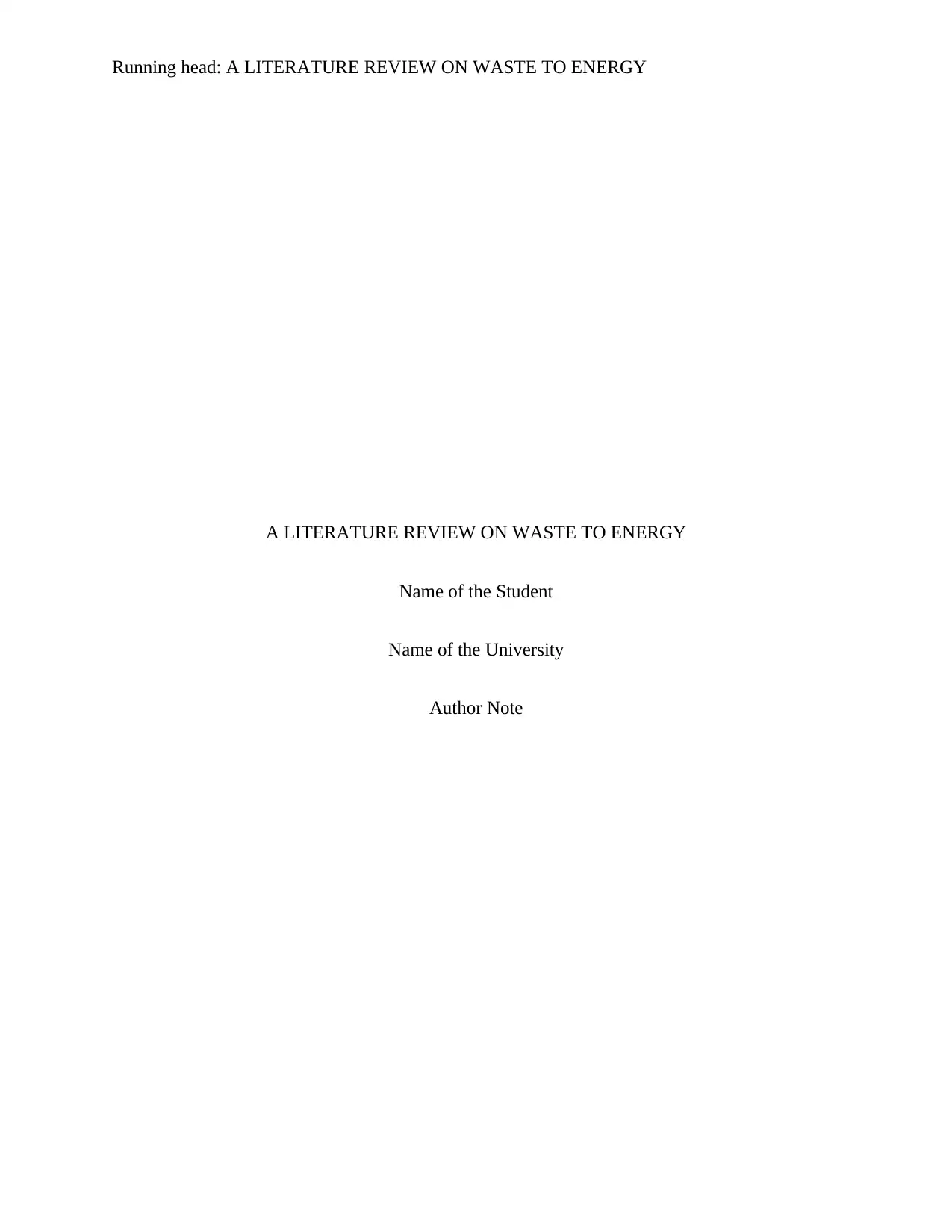
Running head: A LITERATURE REVIEW ON WASTE TO ENERGY
A LITERATURE REVIEW ON WASTE TO ENERGY
Name of the Student
Name of the University
Author Note
A LITERATURE REVIEW ON WASTE TO ENERGY
Name of the Student
Name of the University
Author Note
Paraphrase This Document
Need a fresh take? Get an instant paraphrase of this document with our AI Paraphraser
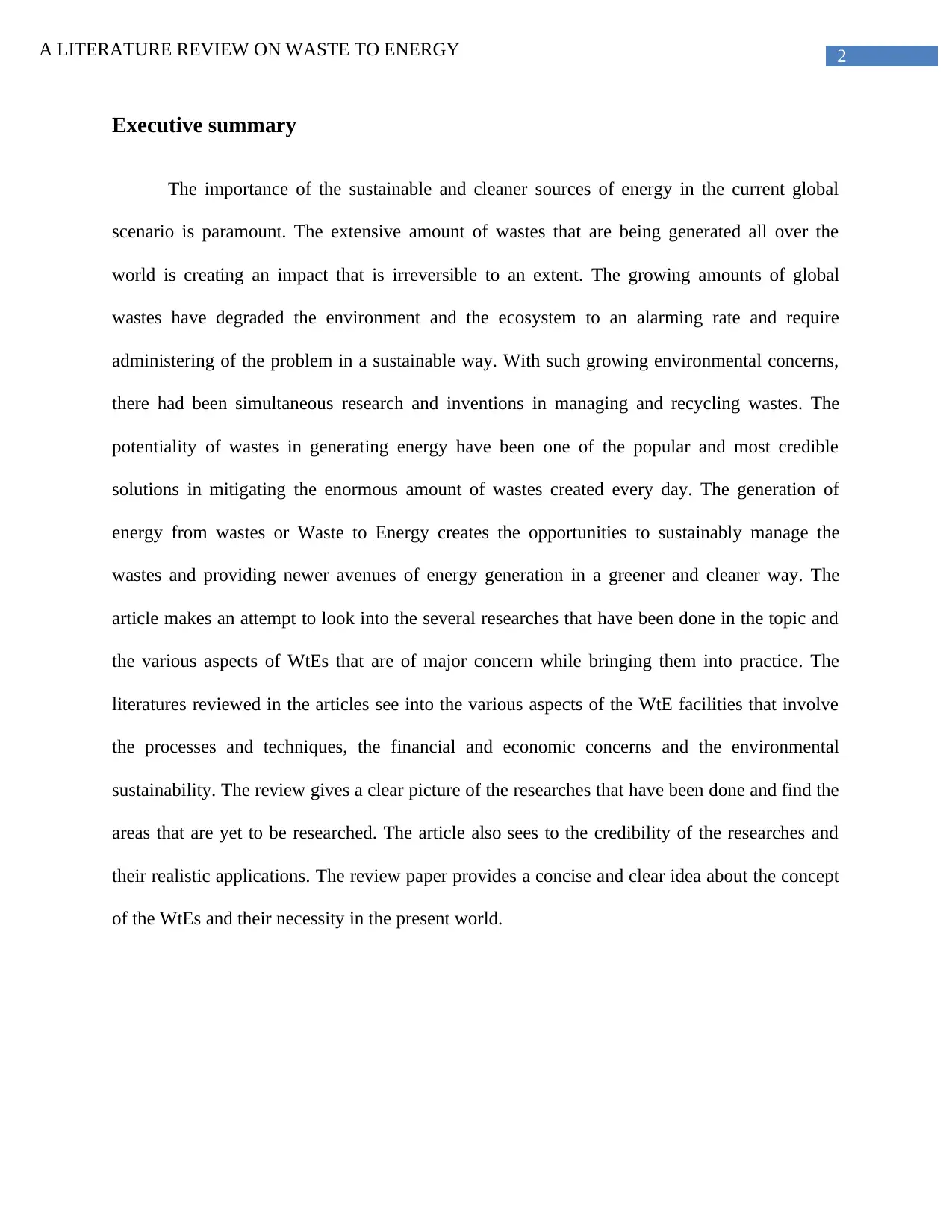
2A LITERATURE REVIEW ON WASTE TO ENERGY
Executive summary
The importance of the sustainable and cleaner sources of energy in the current global
scenario is paramount. The extensive amount of wastes that are being generated all over the
world is creating an impact that is irreversible to an extent. The growing amounts of global
wastes have degraded the environment and the ecosystem to an alarming rate and require
administering of the problem in a sustainable way. With such growing environmental concerns,
there had been simultaneous research and inventions in managing and recycling wastes. The
potentiality of wastes in generating energy have been one of the popular and most credible
solutions in mitigating the enormous amount of wastes created every day. The generation of
energy from wastes or Waste to Energy creates the opportunities to sustainably manage the
wastes and providing newer avenues of energy generation in a greener and cleaner way. The
article makes an attempt to look into the several researches that have been done in the topic and
the various aspects of WtEs that are of major concern while bringing them into practice. The
literatures reviewed in the articles see into the various aspects of the WtE facilities that involve
the processes and techniques, the financial and economic concerns and the environmental
sustainability. The review gives a clear picture of the researches that have been done and find the
areas that are yet to be researched. The article also sees to the credibility of the researches and
their realistic applications. The review paper provides a concise and clear idea about the concept
of the WtEs and their necessity in the present world.
Executive summary
The importance of the sustainable and cleaner sources of energy in the current global
scenario is paramount. The extensive amount of wastes that are being generated all over the
world is creating an impact that is irreversible to an extent. The growing amounts of global
wastes have degraded the environment and the ecosystem to an alarming rate and require
administering of the problem in a sustainable way. With such growing environmental concerns,
there had been simultaneous research and inventions in managing and recycling wastes. The
potentiality of wastes in generating energy have been one of the popular and most credible
solutions in mitigating the enormous amount of wastes created every day. The generation of
energy from wastes or Waste to Energy creates the opportunities to sustainably manage the
wastes and providing newer avenues of energy generation in a greener and cleaner way. The
article makes an attempt to look into the several researches that have been done in the topic and
the various aspects of WtEs that are of major concern while bringing them into practice. The
literatures reviewed in the articles see into the various aspects of the WtE facilities that involve
the processes and techniques, the financial and economic concerns and the environmental
sustainability. The review gives a clear picture of the researches that have been done and find the
areas that are yet to be researched. The article also sees to the credibility of the researches and
their realistic applications. The review paper provides a concise and clear idea about the concept
of the WtEs and their necessity in the present world.
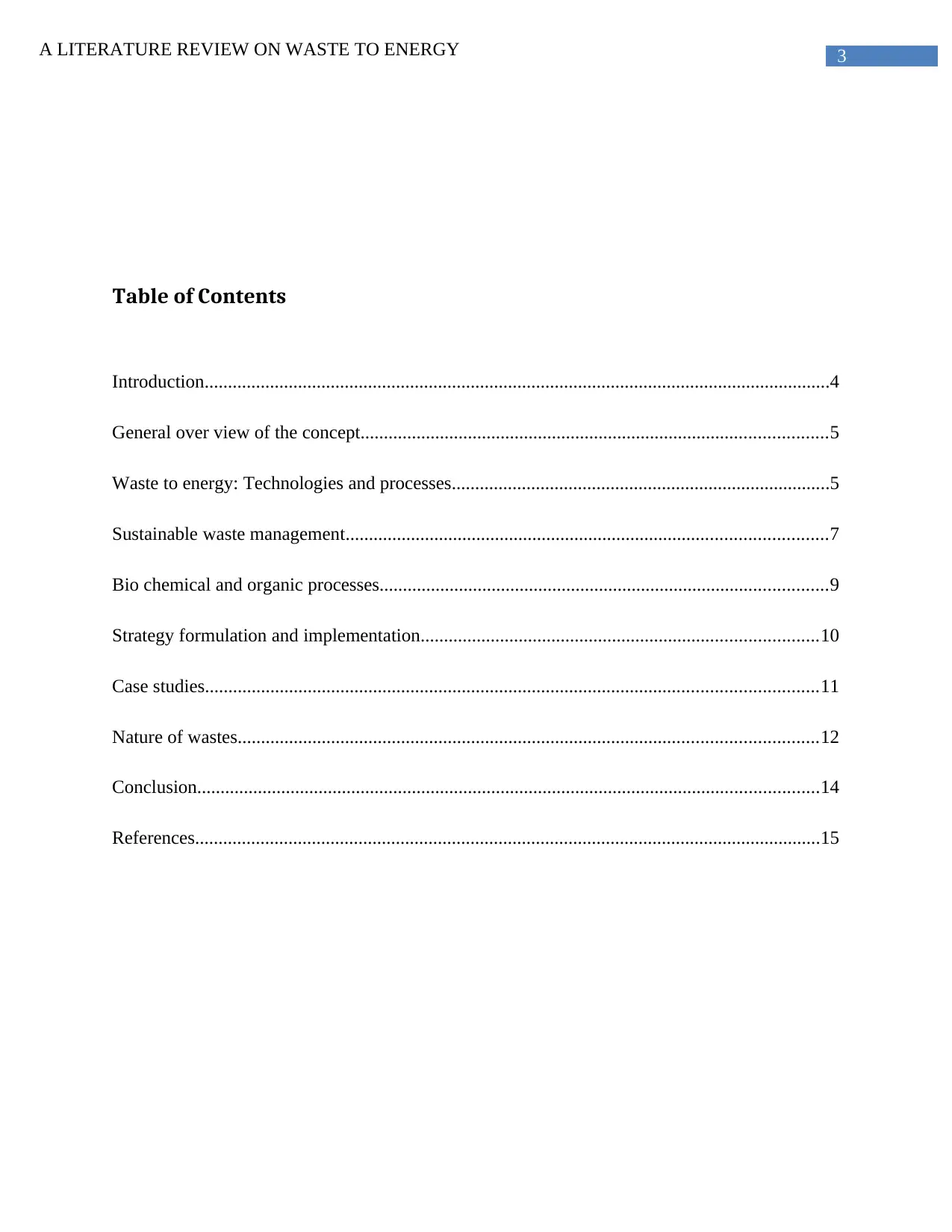
3A LITERATURE REVIEW ON WASTE TO ENERGY
Table of Contents
Introduction......................................................................................................................................4
General over view of the concept....................................................................................................5
Waste to energy: Technologies and processes.................................................................................5
Sustainable waste management.......................................................................................................7
Bio chemical and organic processes................................................................................................9
Strategy formulation and implementation.....................................................................................10
Case studies...................................................................................................................................11
Nature of wastes............................................................................................................................12
Conclusion.....................................................................................................................................14
References......................................................................................................................................15
Table of Contents
Introduction......................................................................................................................................4
General over view of the concept....................................................................................................5
Waste to energy: Technologies and processes.................................................................................5
Sustainable waste management.......................................................................................................7
Bio chemical and organic processes................................................................................................9
Strategy formulation and implementation.....................................................................................10
Case studies...................................................................................................................................11
Nature of wastes............................................................................................................................12
Conclusion.....................................................................................................................................14
References......................................................................................................................................15
⊘ This is a preview!⊘
Do you want full access?
Subscribe today to unlock all pages.

Trusted by 1+ million students worldwide
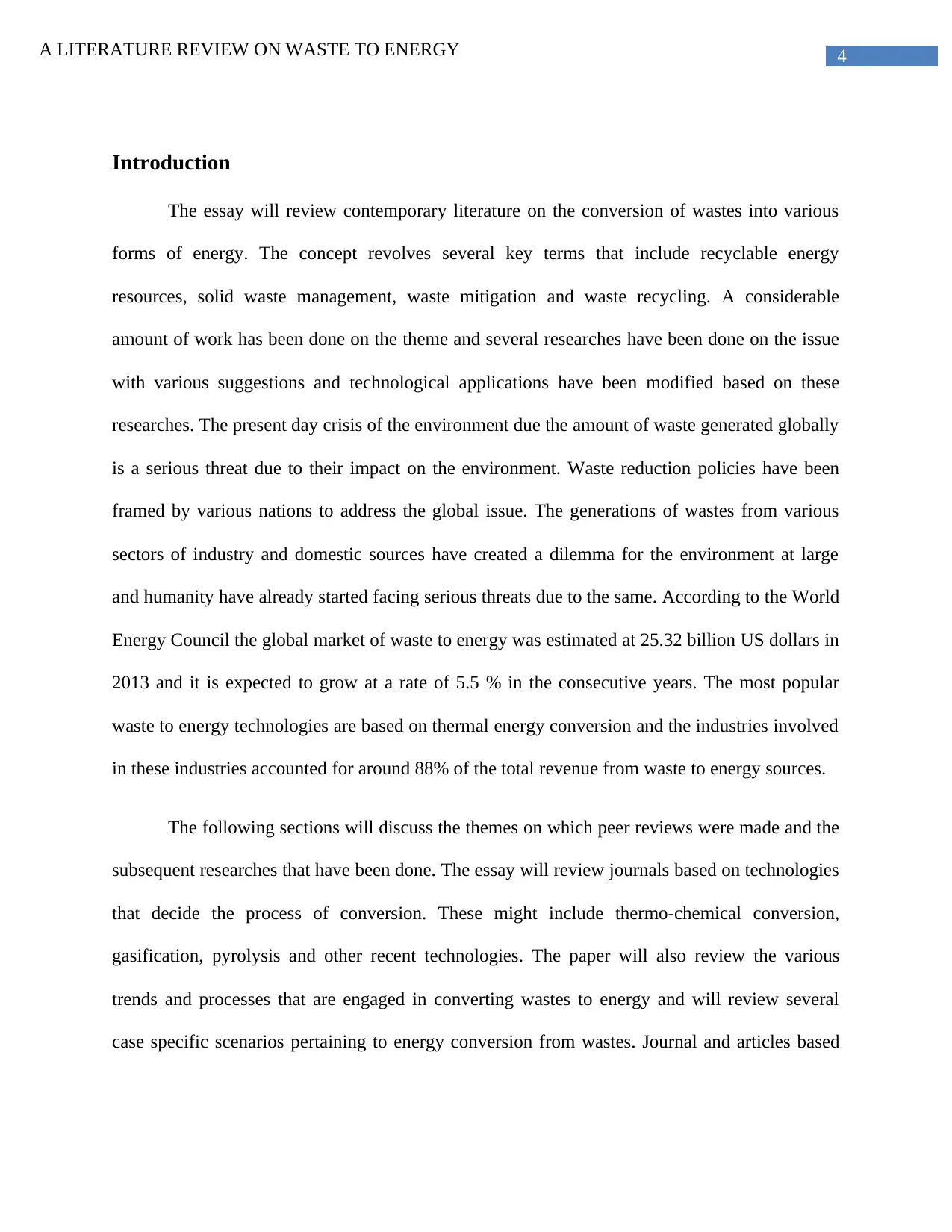
4A LITERATURE REVIEW ON WASTE TO ENERGY
Introduction
The essay will review contemporary literature on the conversion of wastes into various
forms of energy. The concept revolves several key terms that include recyclable energy
resources, solid waste management, waste mitigation and waste recycling. A considerable
amount of work has been done on the theme and several researches have been done on the issue
with various suggestions and technological applications have been modified based on these
researches. The present day crisis of the environment due the amount of waste generated globally
is a serious threat due to their impact on the environment. Waste reduction policies have been
framed by various nations to address the global issue. The generations of wastes from various
sectors of industry and domestic sources have created a dilemma for the environment at large
and humanity have already started facing serious threats due to the same. According to the World
Energy Council the global market of waste to energy was estimated at 25.32 billion US dollars in
2013 and it is expected to grow at a rate of 5.5 % in the consecutive years. The most popular
waste to energy technologies are based on thermal energy conversion and the industries involved
in these industries accounted for around 88% of the total revenue from waste to energy sources.
The following sections will discuss the themes on which peer reviews were made and the
subsequent researches that have been done. The essay will review journals based on technologies
that decide the process of conversion. These might include thermo-chemical conversion,
gasification, pyrolysis and other recent technologies. The paper will also review the various
trends and processes that are engaged in converting wastes to energy and will review several
case specific scenarios pertaining to energy conversion from wastes. Journal and articles based
Introduction
The essay will review contemporary literature on the conversion of wastes into various
forms of energy. The concept revolves several key terms that include recyclable energy
resources, solid waste management, waste mitigation and waste recycling. A considerable
amount of work has been done on the theme and several researches have been done on the issue
with various suggestions and technological applications have been modified based on these
researches. The present day crisis of the environment due the amount of waste generated globally
is a serious threat due to their impact on the environment. Waste reduction policies have been
framed by various nations to address the global issue. The generations of wastes from various
sectors of industry and domestic sources have created a dilemma for the environment at large
and humanity have already started facing serious threats due to the same. According to the World
Energy Council the global market of waste to energy was estimated at 25.32 billion US dollars in
2013 and it is expected to grow at a rate of 5.5 % in the consecutive years. The most popular
waste to energy technologies are based on thermal energy conversion and the industries involved
in these industries accounted for around 88% of the total revenue from waste to energy sources.
The following sections will discuss the themes on which peer reviews were made and the
subsequent researches that have been done. The essay will review journals based on technologies
that decide the process of conversion. These might include thermo-chemical conversion,
gasification, pyrolysis and other recent technologies. The paper will also review the various
trends and processes that are engaged in converting wastes to energy and will review several
case specific scenarios pertaining to energy conversion from wastes. Journal and articles based
Paraphrase This Document
Need a fresh take? Get an instant paraphrase of this document with our AI Paraphraser
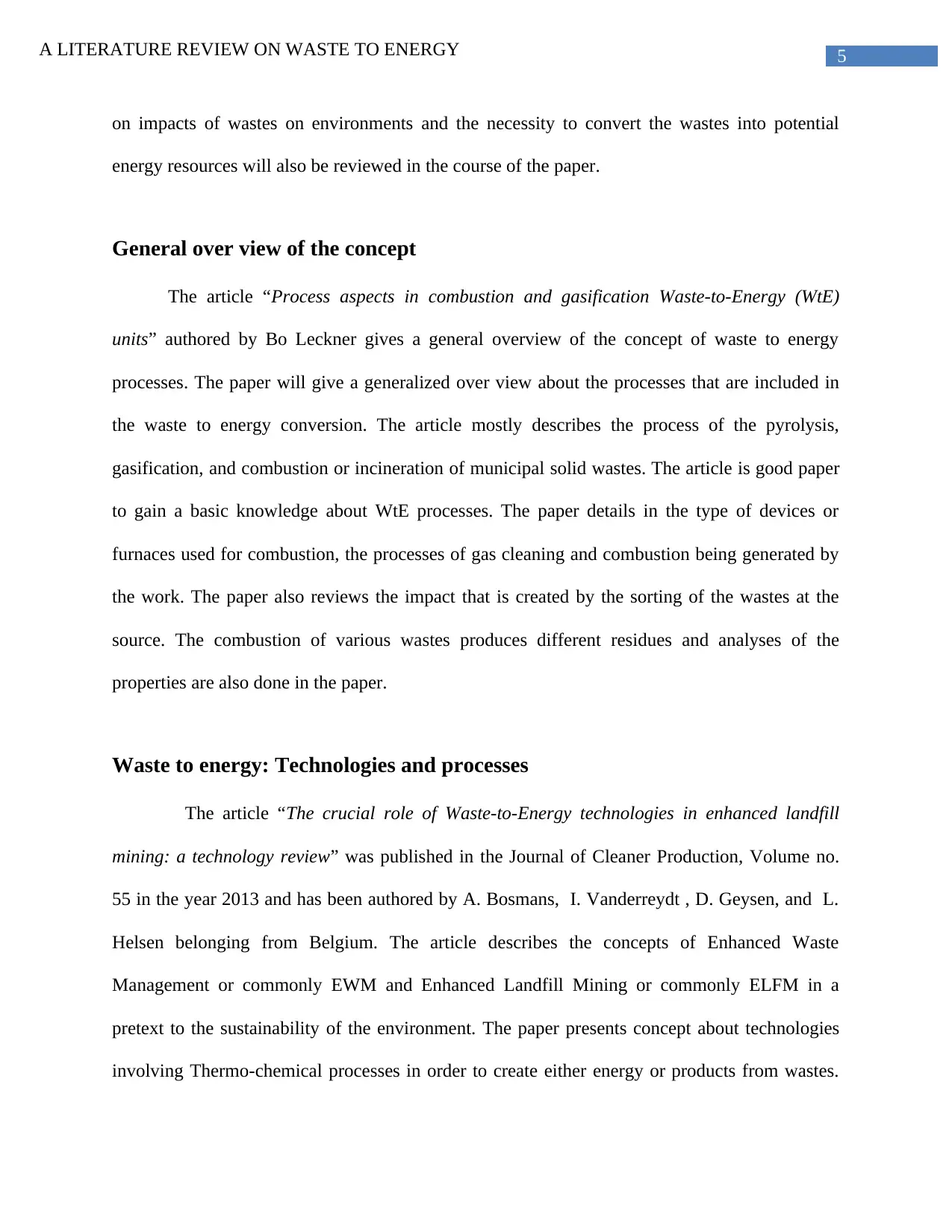
5A LITERATURE REVIEW ON WASTE TO ENERGY
on impacts of wastes on environments and the necessity to convert the wastes into potential
energy resources will also be reviewed in the course of the paper.
General over view of the concept
The article “Process aspects in combustion and gasification Waste-to-Energy (WtE)
units” authored by Bo Leckner gives a general overview of the concept of waste to energy
processes. The paper will give a generalized over view about the processes that are included in
the waste to energy conversion. The article mostly describes the process of the pyrolysis,
gasification, and combustion or incineration of municipal solid wastes. The article is good paper
to gain a basic knowledge about WtE processes. The paper details in the type of devices or
furnaces used for combustion, the processes of gas cleaning and combustion being generated by
the work. The paper also reviews the impact that is created by the sorting of the wastes at the
source. The combustion of various wastes produces different residues and analyses of the
properties are also done in the paper.
Waste to energy: Technologies and processes
The article “The crucial role of Waste-to-Energy technologies in enhanced landfill
mining: a technology review” was published in the Journal of Cleaner Production, Volume no.
55 in the year 2013 and has been authored by A. Bosmans, I. Vanderreydt , D. Geysen, and L.
Helsen belonging from Belgium. The article describes the concepts of Enhanced Waste
Management or commonly EWM and Enhanced Landfill Mining or commonly ELFM in a
pretext to the sustainability of the environment. The paper presents concept about technologies
involving Thermo-chemical processes in order to create either energy or products from wastes.
on impacts of wastes on environments and the necessity to convert the wastes into potential
energy resources will also be reviewed in the course of the paper.
General over view of the concept
The article “Process aspects in combustion and gasification Waste-to-Energy (WtE)
units” authored by Bo Leckner gives a general overview of the concept of waste to energy
processes. The paper will give a generalized over view about the processes that are included in
the waste to energy conversion. The article mostly describes the process of the pyrolysis,
gasification, and combustion or incineration of municipal solid wastes. The article is good paper
to gain a basic knowledge about WtE processes. The paper details in the type of devices or
furnaces used for combustion, the processes of gas cleaning and combustion being generated by
the work. The paper also reviews the impact that is created by the sorting of the wastes at the
source. The combustion of various wastes produces different residues and analyses of the
properties are also done in the paper.
Waste to energy: Technologies and processes
The article “The crucial role of Waste-to-Energy technologies in enhanced landfill
mining: a technology review” was published in the Journal of Cleaner Production, Volume no.
55 in the year 2013 and has been authored by A. Bosmans, I. Vanderreydt , D. Geysen, and L.
Helsen belonging from Belgium. The article describes the concepts of Enhanced Waste
Management or commonly EWM and Enhanced Landfill Mining or commonly ELFM in a
pretext to the sustainability of the environment. The paper presents concept about technologies
involving Thermo-chemical processes in order to create either energy or products from wastes.
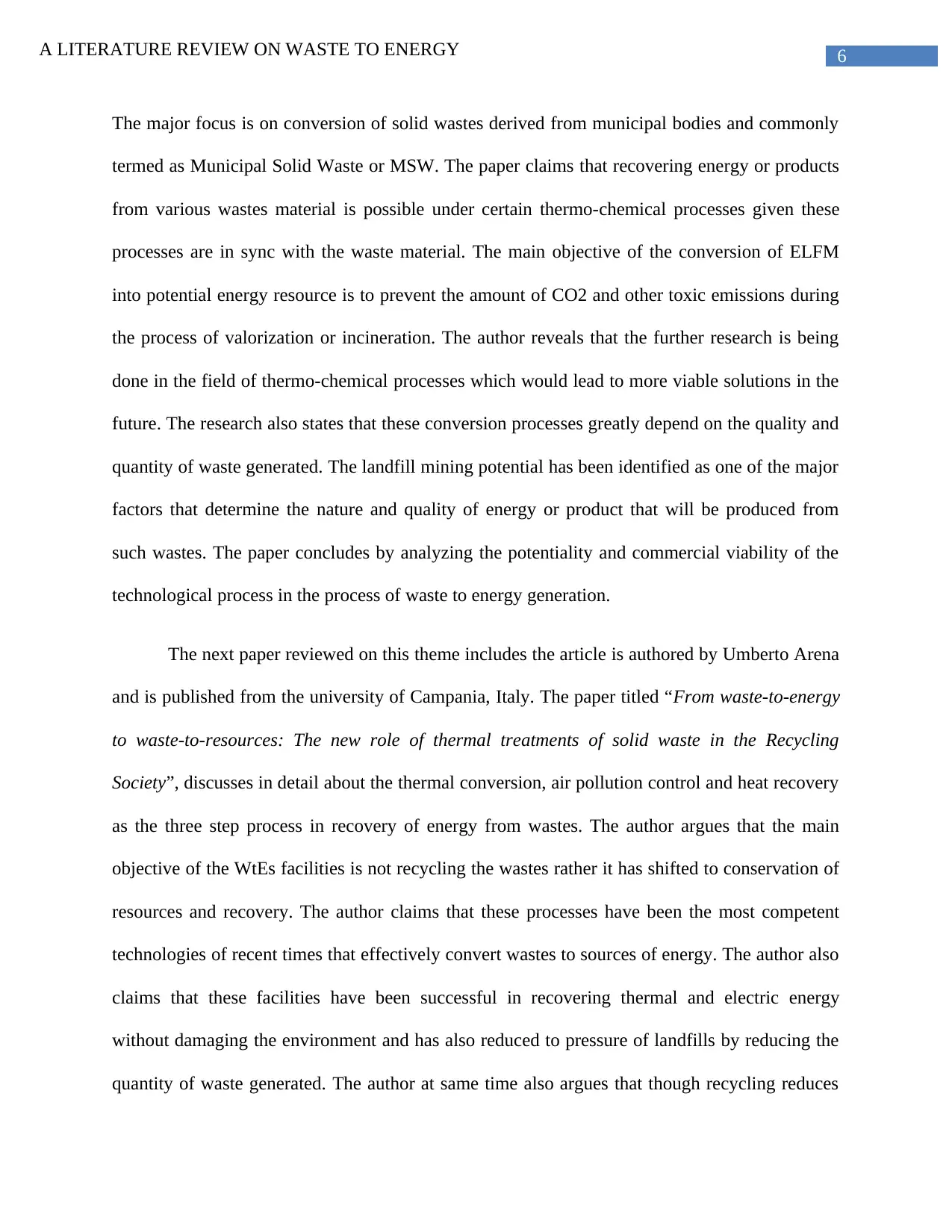
6A LITERATURE REVIEW ON WASTE TO ENERGY
The major focus is on conversion of solid wastes derived from municipal bodies and commonly
termed as Municipal Solid Waste or MSW. The paper claims that recovering energy or products
from various wastes material is possible under certain thermo-chemical processes given these
processes are in sync with the waste material. The main objective of the conversion of ELFM
into potential energy resource is to prevent the amount of CO2 and other toxic emissions during
the process of valorization or incineration. The author reveals that the further research is being
done in the field of thermo-chemical processes which would lead to more viable solutions in the
future. The research also states that these conversion processes greatly depend on the quality and
quantity of waste generated. The landfill mining potential has been identified as one of the major
factors that determine the nature and quality of energy or product that will be produced from
such wastes. The paper concludes by analyzing the potentiality and commercial viability of the
technological process in the process of waste to energy generation.
The next paper reviewed on this theme includes the article is authored by Umberto Arena
and is published from the university of Campania, Italy. The paper titled “From waste-to-energy
to waste-to-resources: The new role of thermal treatments of solid waste in the Recycling
Society”, discusses in detail about the thermal conversion, air pollution control and heat recovery
as the three step process in recovery of energy from wastes. The author argues that the main
objective of the WtEs facilities is not recycling the wastes rather it has shifted to conservation of
resources and recovery. The author claims that these processes have been the most competent
technologies of recent times that effectively convert wastes to sources of energy. The author also
claims that these facilities have been successful in recovering thermal and electric energy
without damaging the environment and has also reduced to pressure of landfills by reducing the
quantity of waste generated. The author at same time also argues that though recycling reduces
The major focus is on conversion of solid wastes derived from municipal bodies and commonly
termed as Municipal Solid Waste or MSW. The paper claims that recovering energy or products
from various wastes material is possible under certain thermo-chemical processes given these
processes are in sync with the waste material. The main objective of the conversion of ELFM
into potential energy resource is to prevent the amount of CO2 and other toxic emissions during
the process of valorization or incineration. The author reveals that the further research is being
done in the field of thermo-chemical processes which would lead to more viable solutions in the
future. The research also states that these conversion processes greatly depend on the quality and
quantity of waste generated. The landfill mining potential has been identified as one of the major
factors that determine the nature and quality of energy or product that will be produced from
such wastes. The paper concludes by analyzing the potentiality and commercial viability of the
technological process in the process of waste to energy generation.
The next paper reviewed on this theme includes the article is authored by Umberto Arena
and is published from the university of Campania, Italy. The paper titled “From waste-to-energy
to waste-to-resources: The new role of thermal treatments of solid waste in the Recycling
Society”, discusses in detail about the thermal conversion, air pollution control and heat recovery
as the three step process in recovery of energy from wastes. The author argues that the main
objective of the WtEs facilities is not recycling the wastes rather it has shifted to conservation of
resources and recovery. The author claims that these processes have been the most competent
technologies of recent times that effectively convert wastes to sources of energy. The author also
claims that these facilities have been successful in recovering thermal and electric energy
without damaging the environment and has also reduced to pressure of landfills by reducing the
quantity of waste generated. The author at same time also argues that though recycling reduces
⊘ This is a preview!⊘
Do you want full access?
Subscribe today to unlock all pages.

Trusted by 1+ million students worldwide
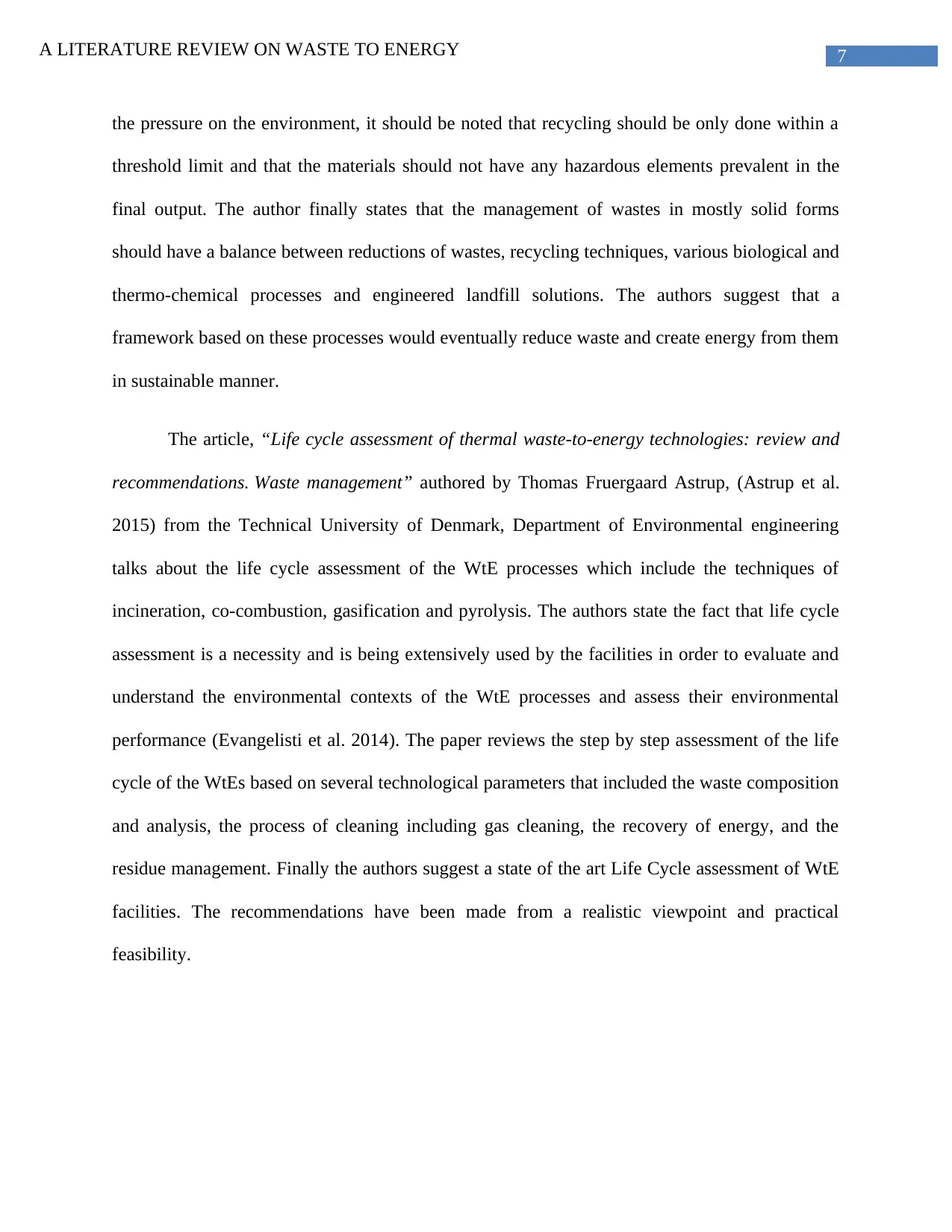
7A LITERATURE REVIEW ON WASTE TO ENERGY
the pressure on the environment, it should be noted that recycling should be only done within a
threshold limit and that the materials should not have any hazardous elements prevalent in the
final output. The author finally states that the management of wastes in mostly solid forms
should have a balance between reductions of wastes, recycling techniques, various biological and
thermo-chemical processes and engineered landfill solutions. The authors suggest that a
framework based on these processes would eventually reduce waste and create energy from them
in sustainable manner.
The article, “Life cycle assessment of thermal waste-to-energy technologies: review and
recommendations. Waste management” authored by Thomas Fruergaard Astrup, (Astrup et al.
2015) from the Technical University of Denmark, Department of Environmental engineering
talks about the life cycle assessment of the WtE processes which include the techniques of
incineration, co-combustion, gasification and pyrolysis. The authors state the fact that life cycle
assessment is a necessity and is being extensively used by the facilities in order to evaluate and
understand the environmental contexts of the WtE processes and assess their environmental
performance (Evangelisti et al. 2014). The paper reviews the step by step assessment of the life
cycle of the WtEs based on several technological parameters that included the waste composition
and analysis, the process of cleaning including gas cleaning, the recovery of energy, and the
residue management. Finally the authors suggest a state of the art Life Cycle assessment of WtE
facilities. The recommendations have been made from a realistic viewpoint and practical
feasibility.
the pressure on the environment, it should be noted that recycling should be only done within a
threshold limit and that the materials should not have any hazardous elements prevalent in the
final output. The author finally states that the management of wastes in mostly solid forms
should have a balance between reductions of wastes, recycling techniques, various biological and
thermo-chemical processes and engineered landfill solutions. The authors suggest that a
framework based on these processes would eventually reduce waste and create energy from them
in sustainable manner.
The article, “Life cycle assessment of thermal waste-to-energy technologies: review and
recommendations. Waste management” authored by Thomas Fruergaard Astrup, (Astrup et al.
2015) from the Technical University of Denmark, Department of Environmental engineering
talks about the life cycle assessment of the WtE processes which include the techniques of
incineration, co-combustion, gasification and pyrolysis. The authors state the fact that life cycle
assessment is a necessity and is being extensively used by the facilities in order to evaluate and
understand the environmental contexts of the WtE processes and assess their environmental
performance (Evangelisti et al. 2014). The paper reviews the step by step assessment of the life
cycle of the WtEs based on several technological parameters that included the waste composition
and analysis, the process of cleaning including gas cleaning, the recovery of energy, and the
residue management. Finally the authors suggest a state of the art Life Cycle assessment of WtE
facilities. The recommendations have been made from a realistic viewpoint and practical
feasibility.
Paraphrase This Document
Need a fresh take? Get an instant paraphrase of this document with our AI Paraphraser
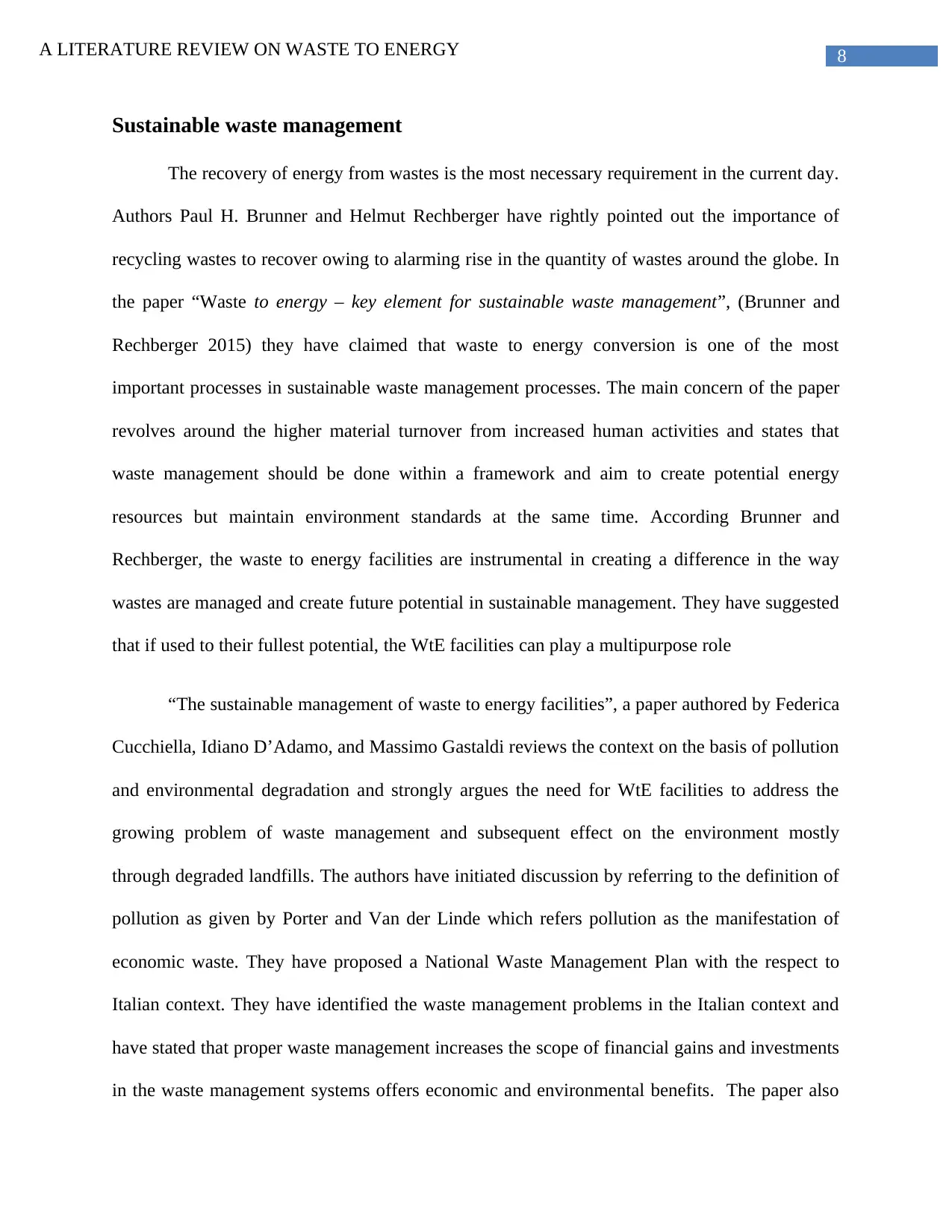
8A LITERATURE REVIEW ON WASTE TO ENERGY
Sustainable waste management
The recovery of energy from wastes is the most necessary requirement in the current day.
Authors Paul H. Brunner and Helmut Rechberger have rightly pointed out the importance of
recycling wastes to recover owing to alarming rise in the quantity of wastes around the globe. In
the paper “Waste to energy – key element for sustainable waste management”, (Brunner and
Rechberger 2015) they have claimed that waste to energy conversion is one of the most
important processes in sustainable waste management processes. The main concern of the paper
revolves around the higher material turnover from increased human activities and states that
waste management should be done within a framework and aim to create potential energy
resources but maintain environment standards at the same time. According Brunner and
Rechberger, the waste to energy facilities are instrumental in creating a difference in the way
wastes are managed and create future potential in sustainable management. They have suggested
that if used to their fullest potential, the WtE facilities can play a multipurpose role
“The sustainable management of waste to energy facilities”, a paper authored by Federica
Cucchiella, Idiano D’Adamo, and Massimo Gastaldi reviews the context on the basis of pollution
and environmental degradation and strongly argues the need for WtE facilities to address the
growing problem of waste management and subsequent effect on the environment mostly
through degraded landfills. The authors have initiated discussion by referring to the definition of
pollution as given by Porter and Van der Linde which refers pollution as the manifestation of
economic waste. They have proposed a National Waste Management Plan with the respect to
Italian context. They have identified the waste management problems in the Italian context and
have stated that proper waste management increases the scope of financial gains and investments
in the waste management systems offers economic and environmental benefits. The paper also
Sustainable waste management
The recovery of energy from wastes is the most necessary requirement in the current day.
Authors Paul H. Brunner and Helmut Rechberger have rightly pointed out the importance of
recycling wastes to recover owing to alarming rise in the quantity of wastes around the globe. In
the paper “Waste to energy – key element for sustainable waste management”, (Brunner and
Rechberger 2015) they have claimed that waste to energy conversion is one of the most
important processes in sustainable waste management processes. The main concern of the paper
revolves around the higher material turnover from increased human activities and states that
waste management should be done within a framework and aim to create potential energy
resources but maintain environment standards at the same time. According Brunner and
Rechberger, the waste to energy facilities are instrumental in creating a difference in the way
wastes are managed and create future potential in sustainable management. They have suggested
that if used to their fullest potential, the WtE facilities can play a multipurpose role
“The sustainable management of waste to energy facilities”, a paper authored by Federica
Cucchiella, Idiano D’Adamo, and Massimo Gastaldi reviews the context on the basis of pollution
and environmental degradation and strongly argues the need for WtE facilities to address the
growing problem of waste management and subsequent effect on the environment mostly
through degraded landfills. The authors have initiated discussion by referring to the definition of
pollution as given by Porter and Van der Linde which refers pollution as the manifestation of
economic waste. They have proposed a National Waste Management Plan with the respect to
Italian context. They have identified the waste management problems in the Italian context and
have stated that proper waste management increases the scope of financial gains and investments
in the waste management systems offers economic and environmental benefits. The paper also
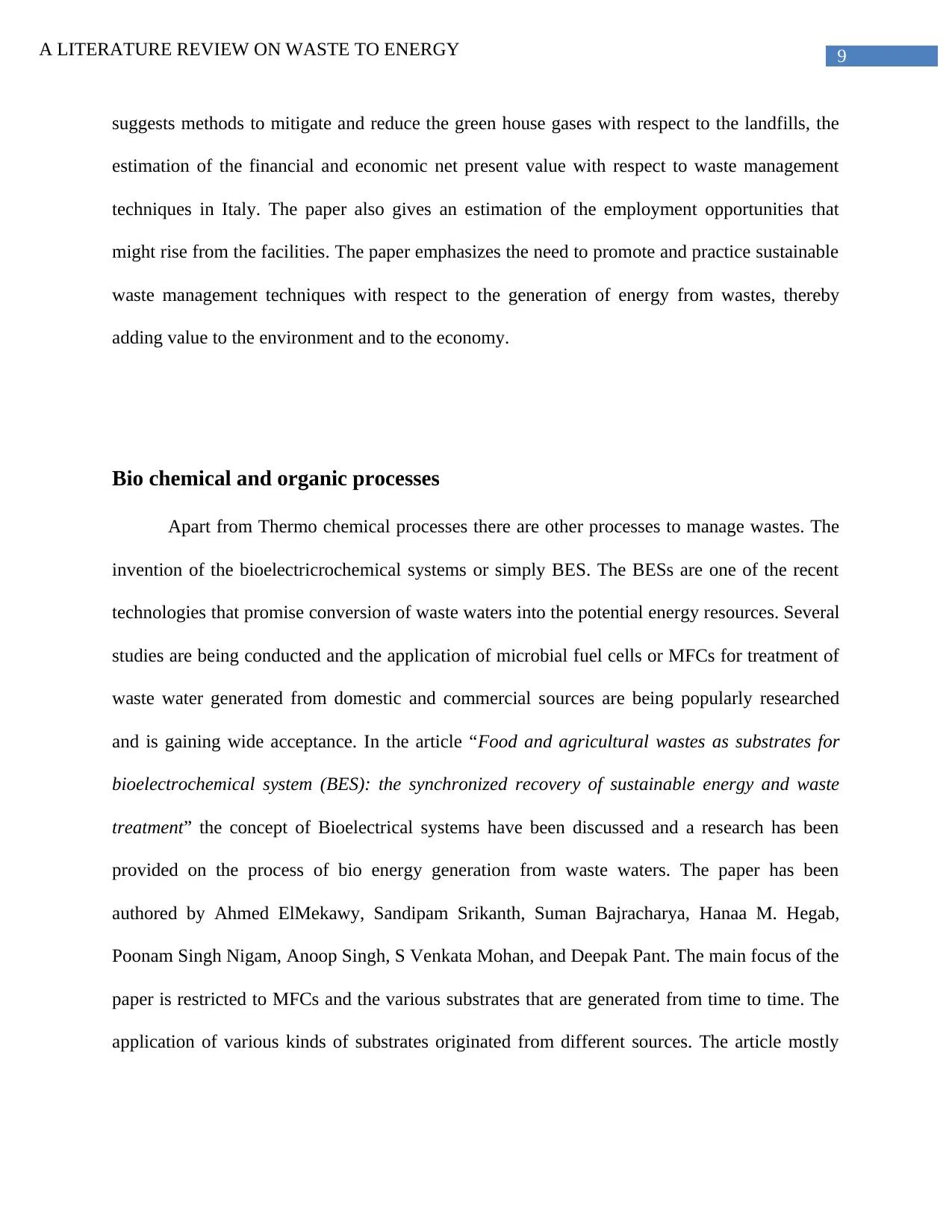
9A LITERATURE REVIEW ON WASTE TO ENERGY
suggests methods to mitigate and reduce the green house gases with respect to the landfills, the
estimation of the financial and economic net present value with respect to waste management
techniques in Italy. The paper also gives an estimation of the employment opportunities that
might rise from the facilities. The paper emphasizes the need to promote and practice sustainable
waste management techniques with respect to the generation of energy from wastes, thereby
adding value to the environment and to the economy.
Bio chemical and organic processes
Apart from Thermo chemical processes there are other processes to manage wastes. The
invention of the bioelectricrochemical systems or simply BES. The BESs are one of the recent
technologies that promise conversion of waste waters into the potential energy resources. Several
studies are being conducted and the application of microbial fuel cells or MFCs for treatment of
waste water generated from domestic and commercial sources are being popularly researched
and is gaining wide acceptance. In the article “Food and agricultural wastes as substrates for
bioelectrochemical system (BES): the synchronized recovery of sustainable energy and waste
treatment” the concept of Bioelectrical systems have been discussed and a research has been
provided on the process of bio energy generation from waste waters. The paper has been
authored by Ahmed ElMekawy, Sandipam Srikanth, Suman Bajracharya, Hanaa M. Hegab,
Poonam Singh Nigam, Anoop Singh, S Venkata Mohan, and Deepak Pant. The main focus of the
paper is restricted to MFCs and the various substrates that are generated from time to time. The
application of various kinds of substrates originated from different sources. The article mostly
suggests methods to mitigate and reduce the green house gases with respect to the landfills, the
estimation of the financial and economic net present value with respect to waste management
techniques in Italy. The paper also gives an estimation of the employment opportunities that
might rise from the facilities. The paper emphasizes the need to promote and practice sustainable
waste management techniques with respect to the generation of energy from wastes, thereby
adding value to the environment and to the economy.
Bio chemical and organic processes
Apart from Thermo chemical processes there are other processes to manage wastes. The
invention of the bioelectricrochemical systems or simply BES. The BESs are one of the recent
technologies that promise conversion of waste waters into the potential energy resources. Several
studies are being conducted and the application of microbial fuel cells or MFCs for treatment of
waste water generated from domestic and commercial sources are being popularly researched
and is gaining wide acceptance. In the article “Food and agricultural wastes as substrates for
bioelectrochemical system (BES): the synchronized recovery of sustainable energy and waste
treatment” the concept of Bioelectrical systems have been discussed and a research has been
provided on the process of bio energy generation from waste waters. The paper has been
authored by Ahmed ElMekawy, Sandipam Srikanth, Suman Bajracharya, Hanaa M. Hegab,
Poonam Singh Nigam, Anoop Singh, S Venkata Mohan, and Deepak Pant. The main focus of the
paper is restricted to MFCs and the various substrates that are generated from time to time. The
application of various kinds of substrates originated from different sources. The article mostly
⊘ This is a preview!⊘
Do you want full access?
Subscribe today to unlock all pages.

Trusted by 1+ million students worldwide
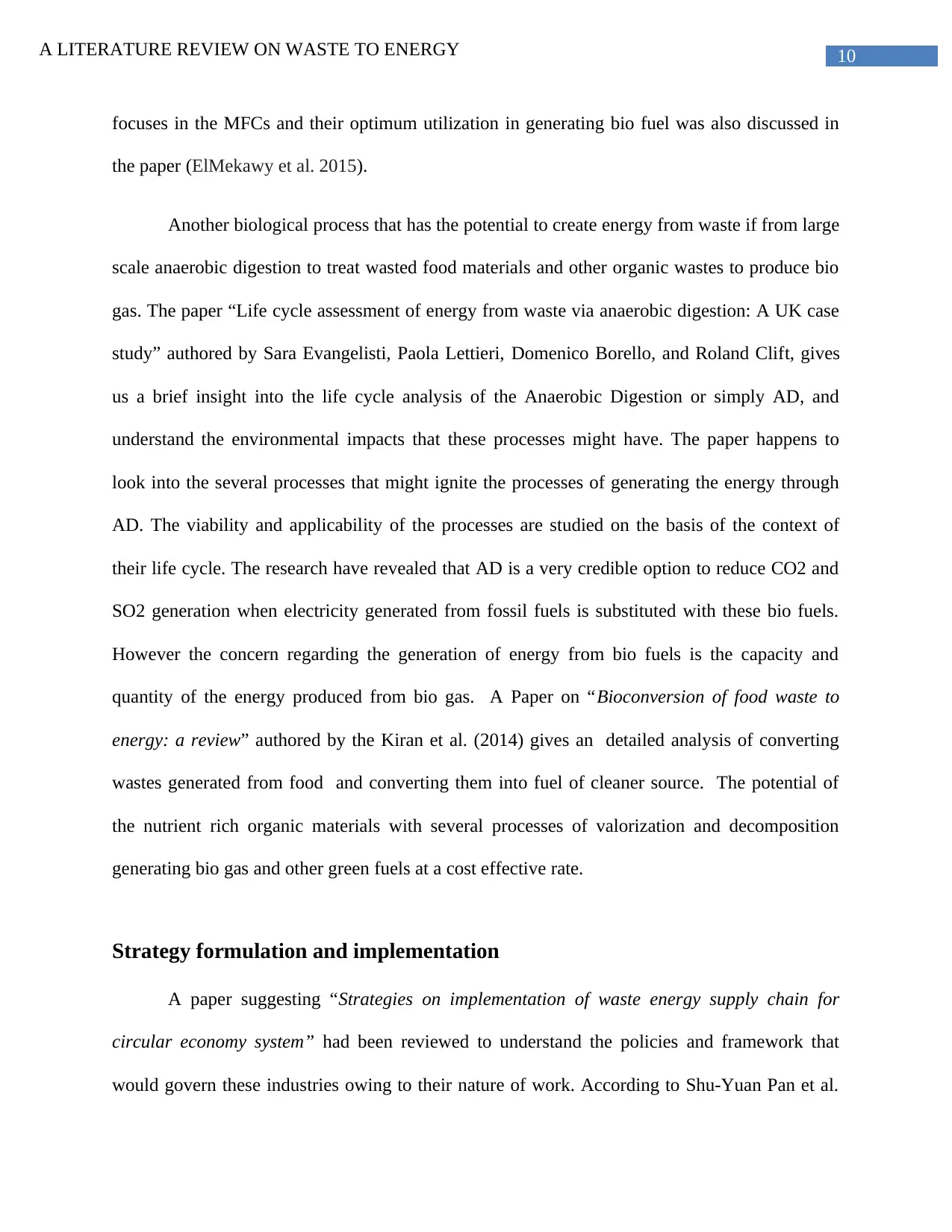
10A LITERATURE REVIEW ON WASTE TO ENERGY
focuses in the MFCs and their optimum utilization in generating bio fuel was also discussed in
the paper (ElMekawy et al. 2015).
Another biological process that has the potential to create energy from waste if from large
scale anaerobic digestion to treat wasted food materials and other organic wastes to produce bio
gas. The paper “Life cycle assessment of energy from waste via anaerobic digestion: A UK case
study” authored by Sara Evangelisti, Paola Lettieri, Domenico Borello, and Roland Clift, gives
us a brief insight into the life cycle analysis of the Anaerobic Digestion or simply AD, and
understand the environmental impacts that these processes might have. The paper happens to
look into the several processes that might ignite the processes of generating the energy through
AD. The viability and applicability of the processes are studied on the basis of the context of
their life cycle. The research have revealed that AD is a very credible option to reduce CO2 and
SO2 generation when electricity generated from fossil fuels is substituted with these bio fuels.
However the concern regarding the generation of energy from bio fuels is the capacity and
quantity of the energy produced from bio gas. A Paper on “Bioconversion of food waste to
energy: a review” authored by the Kiran et al. (2014) gives an detailed analysis of converting
wastes generated from food and converting them into fuel of cleaner source. The potential of
the nutrient rich organic materials with several processes of valorization and decomposition
generating bio gas and other green fuels at a cost effective rate.
Strategy formulation and implementation
A paper suggesting “Strategies on implementation of waste energy supply chain for
circular economy system” had been reviewed to understand the policies and framework that
would govern these industries owing to their nature of work. According to Shu-Yuan Pan et al.
focuses in the MFCs and their optimum utilization in generating bio fuel was also discussed in
the paper (ElMekawy et al. 2015).
Another biological process that has the potential to create energy from waste if from large
scale anaerobic digestion to treat wasted food materials and other organic wastes to produce bio
gas. The paper “Life cycle assessment of energy from waste via anaerobic digestion: A UK case
study” authored by Sara Evangelisti, Paola Lettieri, Domenico Borello, and Roland Clift, gives
us a brief insight into the life cycle analysis of the Anaerobic Digestion or simply AD, and
understand the environmental impacts that these processes might have. The paper happens to
look into the several processes that might ignite the processes of generating the energy through
AD. The viability and applicability of the processes are studied on the basis of the context of
their life cycle. The research have revealed that AD is a very credible option to reduce CO2 and
SO2 generation when electricity generated from fossil fuels is substituted with these bio fuels.
However the concern regarding the generation of energy from bio fuels is the capacity and
quantity of the energy produced from bio gas. A Paper on “Bioconversion of food waste to
energy: a review” authored by the Kiran et al. (2014) gives an detailed analysis of converting
wastes generated from food and converting them into fuel of cleaner source. The potential of
the nutrient rich organic materials with several processes of valorization and decomposition
generating bio gas and other green fuels at a cost effective rate.
Strategy formulation and implementation
A paper suggesting “Strategies on implementation of waste energy supply chain for
circular economy system” had been reviewed to understand the policies and framework that
would govern these industries owing to their nature of work. According to Shu-Yuan Pan et al.
Paraphrase This Document
Need a fresh take? Get an instant paraphrase of this document with our AI Paraphraser
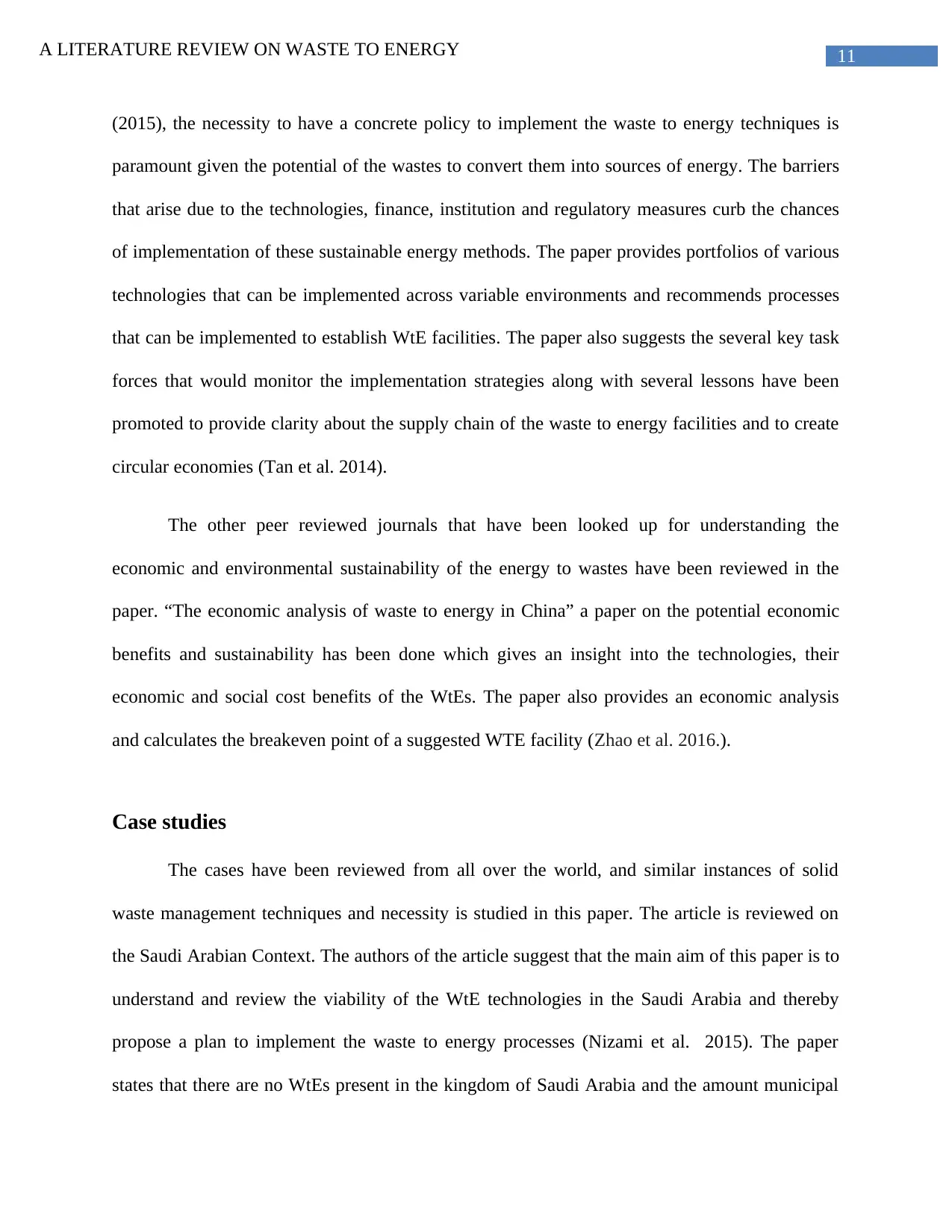
11A LITERATURE REVIEW ON WASTE TO ENERGY
(2015), the necessity to have a concrete policy to implement the waste to energy techniques is
paramount given the potential of the wastes to convert them into sources of energy. The barriers
that arise due to the technologies, finance, institution and regulatory measures curb the chances
of implementation of these sustainable energy methods. The paper provides portfolios of various
technologies that can be implemented across variable environments and recommends processes
that can be implemented to establish WtE facilities. The paper also suggests the several key task
forces that would monitor the implementation strategies along with several lessons have been
promoted to provide clarity about the supply chain of the waste to energy facilities and to create
circular economies (Tan et al. 2014).
The other peer reviewed journals that have been looked up for understanding the
economic and environmental sustainability of the energy to wastes have been reviewed in the
paper. “The economic analysis of waste to energy in China” a paper on the potential economic
benefits and sustainability has been done which gives an insight into the technologies, their
economic and social cost benefits of the WtEs. The paper also provides an economic analysis
and calculates the breakeven point of a suggested WTE facility (Zhao et al. 2016.).
Case studies
The cases have been reviewed from all over the world, and similar instances of solid
waste management techniques and necessity is studied in this paper. The article is reviewed on
the Saudi Arabian Context. The authors of the article suggest that the main aim of this paper is to
understand and review the viability of the WtE technologies in the Saudi Arabia and thereby
propose a plan to implement the waste to energy processes (Nizami et al. 2015). The paper
states that there are no WtEs present in the kingdom of Saudi Arabia and the amount municipal
(2015), the necessity to have a concrete policy to implement the waste to energy techniques is
paramount given the potential of the wastes to convert them into sources of energy. The barriers
that arise due to the technologies, finance, institution and regulatory measures curb the chances
of implementation of these sustainable energy methods. The paper provides portfolios of various
technologies that can be implemented across variable environments and recommends processes
that can be implemented to establish WtE facilities. The paper also suggests the several key task
forces that would monitor the implementation strategies along with several lessons have been
promoted to provide clarity about the supply chain of the waste to energy facilities and to create
circular economies (Tan et al. 2014).
The other peer reviewed journals that have been looked up for understanding the
economic and environmental sustainability of the energy to wastes have been reviewed in the
paper. “The economic analysis of waste to energy in China” a paper on the potential economic
benefits and sustainability has been done which gives an insight into the technologies, their
economic and social cost benefits of the WtEs. The paper also provides an economic analysis
and calculates the breakeven point of a suggested WTE facility (Zhao et al. 2016.).
Case studies
The cases have been reviewed from all over the world, and similar instances of solid
waste management techniques and necessity is studied in this paper. The article is reviewed on
the Saudi Arabian Context. The authors of the article suggest that the main aim of this paper is to
understand and review the viability of the WtE technologies in the Saudi Arabia and thereby
propose a plan to implement the waste to energy processes (Nizami et al. 2015). The paper
states that there are no WtEs present in the kingdom of Saudi Arabia and the amount municipal
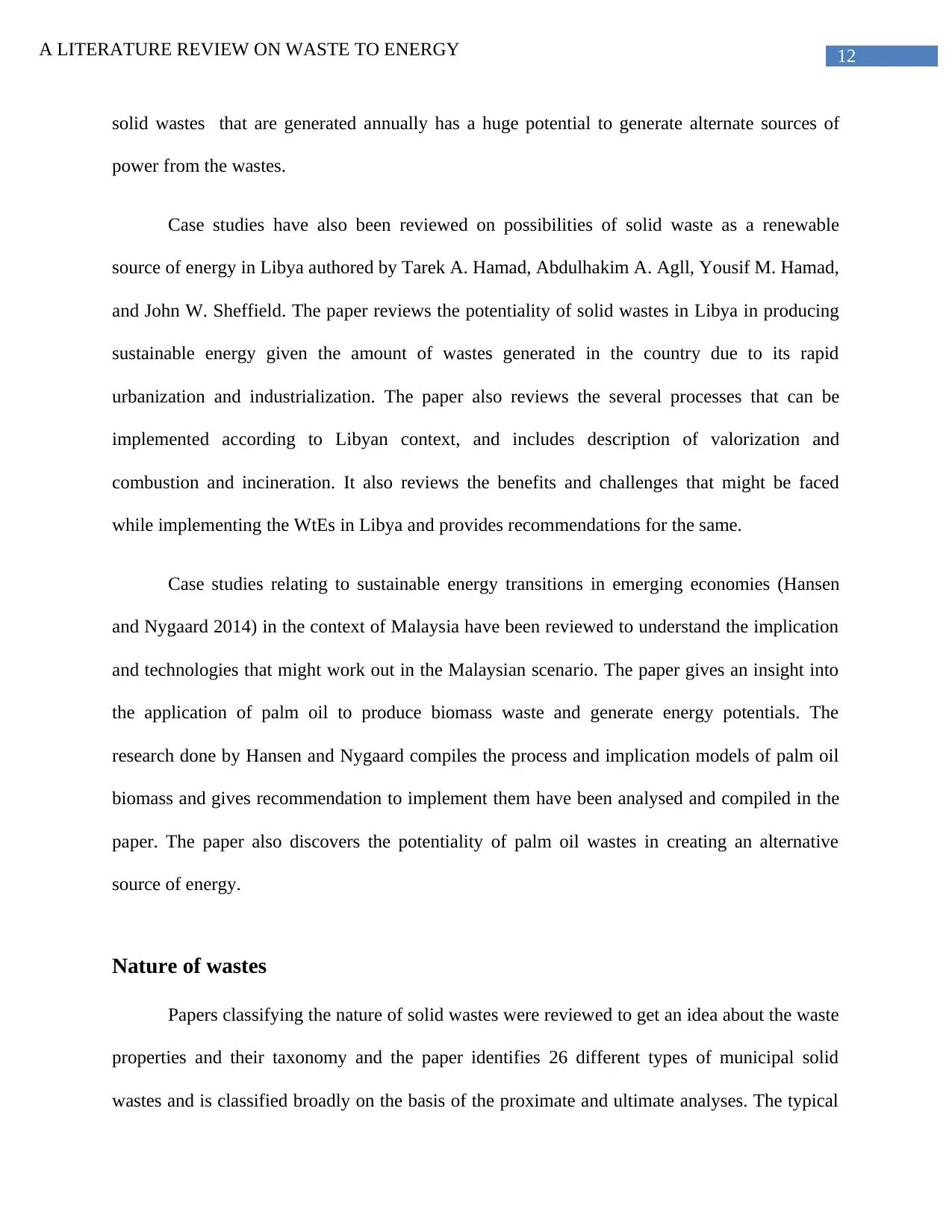
12A LITERATURE REVIEW ON WASTE TO ENERGY
solid wastes that are generated annually has a huge potential to generate alternate sources of
power from the wastes.
Case studies have also been reviewed on possibilities of solid waste as a renewable
source of energy in Libya authored by Tarek A. Hamad, Abdulhakim A. Agll, Yousif M. Hamad,
and John W. Sheffield. The paper reviews the potentiality of solid wastes in Libya in producing
sustainable energy given the amount of wastes generated in the country due to its rapid
urbanization and industrialization. The paper also reviews the several processes that can be
implemented according to Libyan context, and includes description of valorization and
combustion and incineration. It also reviews the benefits and challenges that might be faced
while implementing the WtEs in Libya and provides recommendations for the same.
Case studies relating to sustainable energy transitions in emerging economies (Hansen
and Nygaard 2014) in the context of Malaysia have been reviewed to understand the implication
and technologies that might work out in the Malaysian scenario. The paper gives an insight into
the application of palm oil to produce biomass waste and generate energy potentials. The
research done by Hansen and Nygaard compiles the process and implication models of palm oil
biomass and gives recommendation to implement them have been analysed and compiled in the
paper. The paper also discovers the potentiality of palm oil wastes in creating an alternative
source of energy.
Nature of wastes
Papers classifying the nature of solid wastes were reviewed to get an idea about the waste
properties and their taxonomy and the paper identifies 26 different types of municipal solid
wastes and is classified broadly on the basis of the proximate and ultimate analyses. The typical
solid wastes that are generated annually has a huge potential to generate alternate sources of
power from the wastes.
Case studies have also been reviewed on possibilities of solid waste as a renewable
source of energy in Libya authored by Tarek A. Hamad, Abdulhakim A. Agll, Yousif M. Hamad,
and John W. Sheffield. The paper reviews the potentiality of solid wastes in Libya in producing
sustainable energy given the amount of wastes generated in the country due to its rapid
urbanization and industrialization. The paper also reviews the several processes that can be
implemented according to Libyan context, and includes description of valorization and
combustion and incineration. It also reviews the benefits and challenges that might be faced
while implementing the WtEs in Libya and provides recommendations for the same.
Case studies relating to sustainable energy transitions in emerging economies (Hansen
and Nygaard 2014) in the context of Malaysia have been reviewed to understand the implication
and technologies that might work out in the Malaysian scenario. The paper gives an insight into
the application of palm oil to produce biomass waste and generate energy potentials. The
research done by Hansen and Nygaard compiles the process and implication models of palm oil
biomass and gives recommendation to implement them have been analysed and compiled in the
paper. The paper also discovers the potentiality of palm oil wastes in creating an alternative
source of energy.
Nature of wastes
Papers classifying the nature of solid wastes were reviewed to get an idea about the waste
properties and their taxonomy and the paper identifies 26 different types of municipal solid
wastes and is classified broadly on the basis of the proximate and ultimate analyses. The typical
⊘ This is a preview!⊘
Do you want full access?
Subscribe today to unlock all pages.

Trusted by 1+ million students worldwide
1 out of 19
Related Documents
Your All-in-One AI-Powered Toolkit for Academic Success.
+13062052269
info@desklib.com
Available 24*7 on WhatsApp / Email
![[object Object]](/_next/static/media/star-bottom.7253800d.svg)
Unlock your academic potential
Copyright © 2020–2025 A2Z Services. All Rights Reserved. Developed and managed by ZUCOL.




